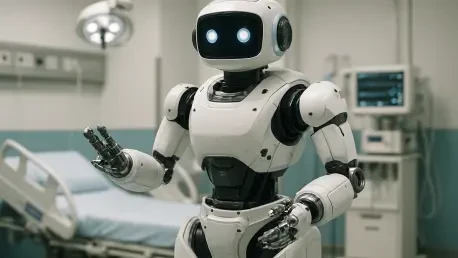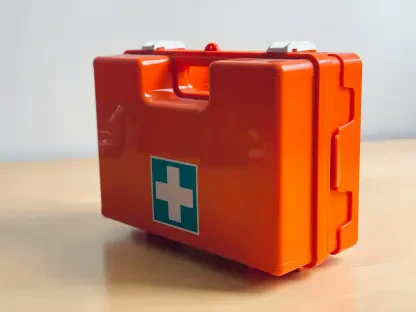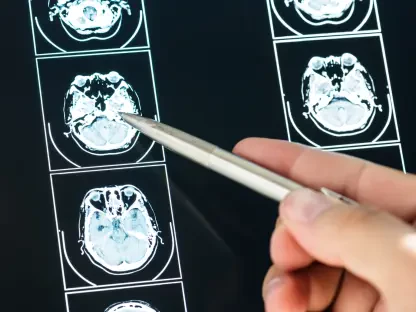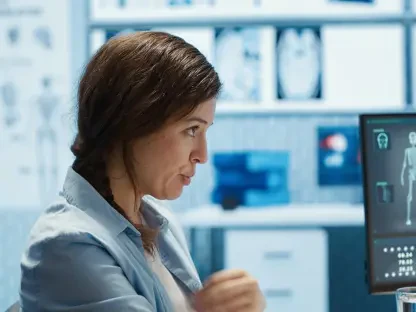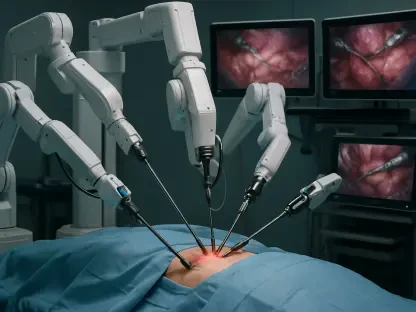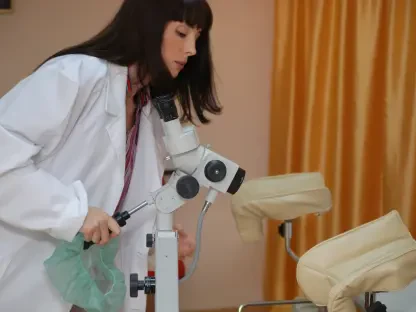Imagine a future where a surgeon in New York operates on a patient in a remote African village without ever leaving their hospital, or where a stroke survivor regains mobility with the help of a robotic exoskeleton tailored to their needs. This is not science fiction but the rapidly approaching reality of medical robotics, a field poised to redefine healthcare delivery. Valued at USD 31.11 billion in 2024, the global medical robots market is projected to surge to an astounding USD 145.7 billion by 2035, driven by a compound annual growth rate (CAGR) of 15.2%. These machines, infused with cutting-edge technologies like artificial intelligence (AI) and telemedicine, promise to enhance precision, reduce errors, and improve patient outcomes on an unprecedented scale.
The scope of medical robots extends far beyond the operating room, touching areas such as rehabilitation, diagnostics, and hospital logistics. They are designed to alleviate the burden on healthcare professionals while addressing critical challenges like an aging population and rising chronic diseases. By 2035, their integration into daily medical practice could mean faster recoveries, safer procedures, and more efficient hospital operations. As automation and AI continue to evolve, robots are becoming not just tools but intelligent partners in care, capable of adapting to complex scenarios with remarkable accuracy.
This transformative potential is fueled by a pressing need for innovation in healthcare. The demand for minimally invasive procedures, coupled with labor shortages and infection control concerns highlighted by crises like COVID-19, underscores the urgency for robotic solutions. From surgical assistance to disinfecting hospital wards, these technologies are set to revolutionize how care is provided. Looking ahead to 2035, the journey of medical robotics offers a glimpse into a future where technology and human expertise converge to create a more effective and accessible healthcare system.
Revolutionizing Clinical Applications
Enhancing Surgical Outcomes
Medical robots are already making waves in surgery, and by 2035, their impact is expected to be transformative. Systems like the Da Vinci Surgical System enable minimally invasive procedures with exceptional precision, reducing complications such as blood loss and shortening patient recovery times. Over the next decade, advancements in AI will allow these robots to analyze vast datasets of past surgeries, aiding surgeons in real-time decision-making during complex operations. This will broaden their application across specialties like neurosurgery, orthopedics, and cardiology, ensuring safer outcomes and expanding access to high-quality surgical care in diverse settings.
Another frontier is telerobotics, which allows surgeons to perform procedures remotely, breaking down geographical barriers. By 2035, improvements in 5G connectivity and cloud-based systems will make remote surgeries a standard practice, enabling specialists to treat patients in rural or disaster-stricken areas without the need for travel. This capability will be particularly critical in emergencies, where immediate access to expert care can save lives. The potential to connect skilled professionals with underserved regions globally marks a significant leap toward equitable healthcare, redefining the boundaries of surgical intervention.
Advancing Rehabilitation and Eldercare
In the realm of rehabilitation, medical robots are set to play a pivotal role by 2035, particularly for an aging population. Wearable robotic exoskeletons are already assisting patients with mobility impairments caused by conditions like stroke or spinal cord injuries. These devices support physical therapy by guiding movements and building strength, helping individuals regain independence. As technology advances, such systems will become lighter, more intuitive, and cost-effective, making them accessible to a wider range of patients and reducing reliance on human caregivers for daily support.
Beyond individual recovery, robots are emerging as vital tools in eldercare, addressing the growing demand for long-term solutions. By 2035, robotic assistants could help seniors with routine tasks, monitor vital signs, and provide companionship, easing the strain on healthcare systems facing caregiver shortages. Unlike traditional care models, these technologies offer consistent, round-the-clock support, tailored to specific needs through AI-driven personalization. This shift not only enhances quality of life for the elderly but also allows medical facilities to allocate human resources to more critical areas, optimizing overall care delivery.
Addressing Challenges in Adoption
Tackling Financial and Training Obstacles
While the promise of medical robots is immense, their adoption faces significant financial challenges that must be resolved by 2035. The cost of acquiring robotic systems, often running into millions of dollars, poses a barrier for smaller hospitals and those in resource-limited regions. Maintenance expenses and the need for regular upgrades further compound the issue, requiring dedicated budgets that many facilities lack. Without scalable, cost-effective solutions, the benefits of robotics risk remaining out of reach for a large segment of the healthcare sector, perpetuating disparities in access to advanced care.
Equally pressing is the demand for specialized training to operate these complex systems. By 2035, the shortage of skilled personnel familiar with robotic technology could hinder widespread implementation. Training programs are often time-intensive and costly, creating a steep learning curve for surgeons and nurses. Developing accessible, efficient training methods—potentially through virtual reality (VR) and augmented reality (AR) simulations—will be crucial to equip healthcare professionals with the necessary expertise. Bridging this skills gap is essential to ensure that the full potential of medical robots is realized across diverse medical environments.
Navigating Integration and Safety Issues
Integrating medical robots into existing hospital frameworks presents another hurdle on the path to 2035. Compatibility with electronic health records (EHRs) and traditional workflows often proves cumbersome, leading to disruptions rather than the intended efficiency. Hospitals may need to overhaul infrastructure or invest in additional software to align robotic systems with current practices, a process that can be both costly and time-consuming. Streamlining these integrations through standardized protocols and interoperable technologies will be vital to minimize operational friction and maximize the benefits of automation.
Safety concerns also loom large, as even minor software glitches or mechanical failures in robotic systems can result in serious consequences during procedures. By 2035, establishing rigorous safety standards and fail-safe mechanisms will be non-negotiable to maintain trust among healthcare providers and patients. Regulatory bodies must work alongside manufacturers to address liability issues and ensure accountability, particularly as AI-driven robots take on more autonomous roles in clinical settings. Overcoming these safety and integration challenges will determine how seamlessly medical robotics can transform healthcare delivery in the coming years.
Unlocking Future Opportunities
Innovating Access Through New Models
The trajectory of medical robots by 2035 is brimming with opportunities to expand access to cutting-edge care. Innovative business models like robot-as-a-service (RaaS) are emerging as a solution to financial barriers, allowing hospitals to utilize robotic systems without the burden of significant upfront investments. This approach enables smaller facilities to adopt advanced technologies, leveling the playing field and fostering broader implementation. Such models, supported by public-private partnerships, could accelerate the democratization of robotics, ensuring that even resource-constrained regions benefit from these advancements.
Targeting emerging markets in Asia, Africa, and Latin America offers another avenue for growth. These regions, characterized by high surgical volumes and growing healthcare demands, represent untapped potential for affordable robotic platforms. By 2035, tailoring cost-effective solutions to local needs—coupled with government incentives for digital healthcare—could drive substantial market expansion. This focus not only addresses global health inequities but also positions medical robotics as a cornerstone of scalable, inclusive care, transforming how medical services are delivered in diverse socioeconomic contexts.
Pioneering Solutions in Eldercare and Diagnostics
Robotics in eldercare is poised for significant growth by 2035, driven by the rising global elderly population. Beyond mobility aids, robots could monitor health metrics, assist with medication adherence, and provide real-time alerts to medical teams, reducing hospital readmissions. These technologies offer a sustainable alternative to traditional care models, particularly in areas facing caregiver shortages. As AI enhances personalization, robotic solutions will adapt to individual preferences and medical histories, creating a more dignified and independent aging experience for seniors worldwide.
Diagnostic capabilities of medical robots are also set to advance dramatically by 2035, leveraging AI for early disease detection and chronic condition management. Wearable devices and robotic imaging systems will enable continuous monitoring, delivering data-driven insights for personalized treatment plans. This shift toward preventive care aligns with value-based healthcare models, prioritizing outcomes over volume. Supported by innovations in cloud computing and connectivity, these diagnostic tools will empower patients and providers alike, heralding a future where medical robots play a central role in proactive health management.
Shaping a Collaborative Healthcare Future
Reflecting on Past Milestones
Looking back, the journey of medical robots had already shown remarkable progress by the early 2020s, with systems like the Da Vinci Surgical System setting benchmarks in precision surgery. Their ability to reduce recovery times and minimize errors had gained traction among leading hospitals, particularly in North America. The urgency of global health crises, such as the COVID-19 pandemic, had further accelerated adoption, as automation in disinfection and logistics proved invaluable in managing infection risks and staff shortages. These early successes laid a strong foundation for the rapid advancements that followed.
Equally significant were the strides made in rehabilitation robotics during those formative years. Wearable exoskeletons had begun transforming recovery for patients with mobility impairments, offering hope and independence to countless individuals. Government funding and private sector innovation had fueled research, driving down costs and enhancing capabilities. By reflecting on these milestones, it became clear that the groundwork for a robotic revolution in healthcare had been firmly established, setting the stage for the transformative decade leading up to 2035.
Building Toward Tomorrow’s Solutions
As the focus shifts to the future, actionable steps must be prioritized to sustain the momentum of medical robotics through 2035. Investment in affordable technologies and scalable training programs will be critical to ensure broader access, particularly in underserved regions. Governments and industry leaders should collaborate to create regulatory frameworks that balance innovation with safety, addressing ethical concerns around AI autonomy. These efforts will help build trust and facilitate the seamless integration of robots into diverse healthcare settings.
Moreover, fostering global partnerships can unlock new markets and drive innovation in areas like eldercare and remote diagnostics. Encouraging the development of RaaS models and leveraging advancements in 5G for telerobotics will further expand reach, making high-quality care a reality for all. By 2035, the vision of a collaborative healthcare ecosystem—where robots and humans work hand in hand—depends on strategic planning and a commitment to overcoming current barriers. This forward-thinking approach promises not just technological progress but a reimagined standard of patient care worldwide.
